Art and architecture
The works of art on the co-operate campus of Empa and Eawag in Dübendorf and on the Empa site in St. Gallen are as diverse as the research and the international lab teams at the two institutes. Thus the artistic engagement with the sites and their buildings has taken shape in a number of artworks since the 1960s. Other works have been inspired by employees or are an expression of innovative signage.
Julian Charrière - Not to Get Lost
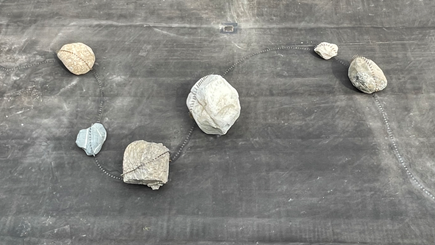
In his works, the Swiss-French artist Julian Charrière combines research topics from various areas of natural science and cultural history. His projects are often the result of field research in remote places such as ice fields or volcanoes. On the co-operate campus, Charrière has created an installation with boulders of different origins, sizes and compositions. The stones are connected by metallic stone wedges, which the artist compares to "acupuncture transferred into physics". On the square between NEST and the new lab building, the boulders with the stone wedges stand in their material originality opposite the buildings in which innovative materials and technologies are developed.
Julian Charrière *1987
Not to Get Lost
2024
Installation, stone and metal
Empa-Eawag campus, between NEST and laboratory building, Dübendorf
Ursula Damm und Felix Bonowski - Kontinuum
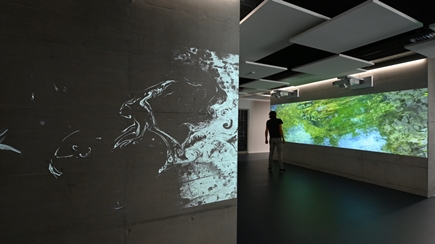
The video installation Kontinuum is a two-channel projection based on live data from the Chriesbach, which flows past the Empa-Eawag campus. The two projections represent the state of the Chriesbach over the course of a year and translate the data on seasonal fluctuations, color patterns and physical principles into sensual images reminiscent of impressionist and Japanese painting. By bringing the outside into the inside, the water into the FLUX building, the object of observation into the place of its investigation, the installation aesthetically reflects the Kontinuum of the stream and the function of the building as part of Eawag's water research. For this purpose, real-time images from three cameras are fed through a graphic shader. This is based on the learning rules of a neural network. The resulting video is a collage of combined aspects of the visual appearance of the Chriesbach from different times and perspectives. The measurements are taken from a station operated by the research institute, which is only a few meters away from where the cameras are looking at the stream. The correspondences between the measurements and the model parameters are chosen so that seasonal changes (temperature), daily rhythms (oxygen saturation due to photosynthesis) and occasional events (turbidity due to thunderstorms and construction work) leave their mark on the graphs.
Ursula Damm *1960 and Felix Bonowski *1983
Kontinuum
2021
Video projections
Empa-Eawag campus, interior of the Flux building, Dübendorf
Roman Signer - Fasslager
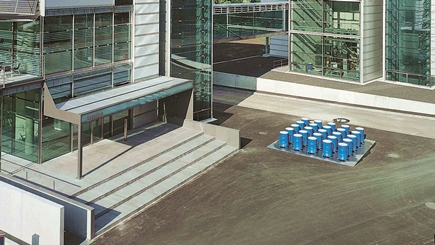
Roman Signer is a Swiss sculptor, draughtsman, action and conceptual artist and filmmaker. He lives and works in St. Gallen. In front of the main entrance to Empa in St. Gallen, he has set up his humming Fasslager. A square of 25 inverted bright blue metal barrels with a white base stands in a shallow tub. Under each barrel is a nozzle from which an invisible jet of water sprays into the barrel. The jet hits the bottom of the barrel, falls back or runs along the walls into the tub. The water jets cause the barrels to vibrate, creating a humming sound.
Roman Signer *1938
Fasslager
2006
25 metal barrels with water jets
Empa main entrance, St. Gallen
Jürg Altherr - Heckenkörper – Körper ohne Haut
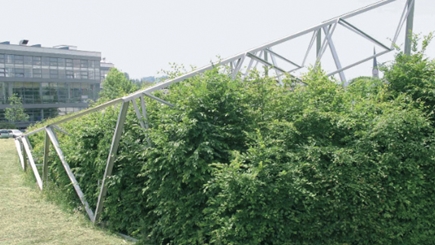
Jürg Altherr was a Swiss sculptor, plastic artist and landscape architect. His work includes sculptures, conceptual art, body art, jewelry, land art, action art and environmental design. Altherr erected his Heckenkörper in the foothills of a strip of reed. It consists of a steel frame that reaches seven meters at its highest point and extends over 70 meters. The construction is placed loosely on a gravel bed. Altherr's Heckenkörper becomes a kind of hinge between technology and nature, built-up surroundings and a landscape more or less left to its own devices.
Jürg Altherr
1944 -2018
Heckenkörper / Körper ohne Haut
1998
Galvanized steel struts, 70 x 7 m
Empa west side, St. Gallen
Robert Lienhard - Nénuphar
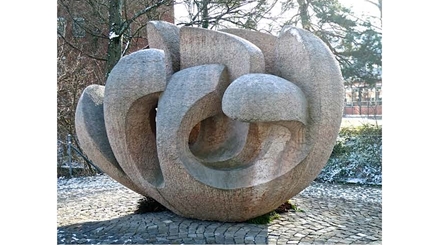
The Winterthur artist Robert Lienhard worked as a sculptor, metal sculptor, draughtsman and graphic artist and on art in public spaces. He created his free-standing sculpture Nénuphar (French for water lily) with forms inspired by nature. Lienhard's involvement with the work of the sculptor Henry Moore is obvious. According to the SIKART encyclopedia, his formal language shows surrealistic allusions to Eros, death and aggression and the central theme of the empty center. Around 1920, Robert Lienhard was one of the first artists in the region to turn to abstract art. Lienhard had the red Veronese lime roughly hewn in an Italian quarry. The transportation to Switzerland, or rather the customs, was difficult: The customs officers already considered the roughly hewn block to be a work of art and not just material. It took a while to pass through customs before experts certified that it was still stone and not art.
Robert Lienhard
1919-1989
Nénuphar
1972
Sculpture made of Veronese limestone
Empa-Eawag campus, forecourt of the Flux building, Dübendorf
Albert Rouiller - Ohne Titel
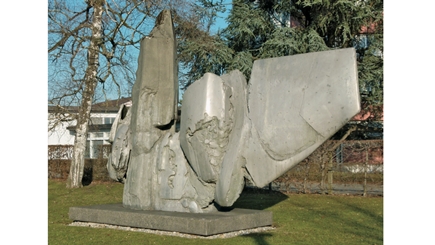
Albert Rouiller was an artist from western Switzerland and co-founder of the Geneva Sculptors' Association. His work includes sculptures, public art, drawings and prints. Initially, Rouiller worked mainly in stone. After 1962, he began a phase of working with various metals. He often created sculptures such as Untitled on the Empa-Eawag campus using various materials. His abstract sculptures are reminiscent of the organic, sometimes the mechanical or surrealistic. Quote: "Man leaves the trace of his work on every material he touches."
Albert Rouiller
1938 - 2000
Untitled
1963
Free-standing sculpture made of aluminum and concrete
Campus Empa-Eawag, green space at the Empa Academy, Dübendorf
Further work on the campus
Stauffenegger + Partner - Water molecule
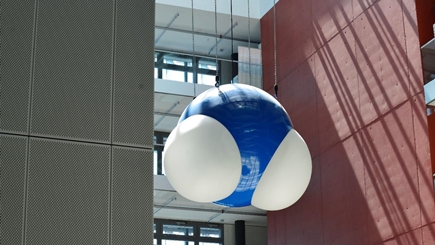
The approximately three-meter plastic model presents water as a central element of Eawag research in an unconventional way. As an oversized, hanging dome model of a water molecule, it also allows multifunctional and unrestricted use of the atrium of the main Eawag building. Thanks to integrated projectors, the two hemispheres of the hydrogen molecules can be used as a communication medium.
Stauffenegger + Partner (signaling)
Water molecule
2004-2008
Plastic model with integrated projectors
Empa-Eawag Campus, Forum Chriesbach, Atrium, Dübendorf
Arthur Bechtiger alias Giustino Corradini - Globophonium
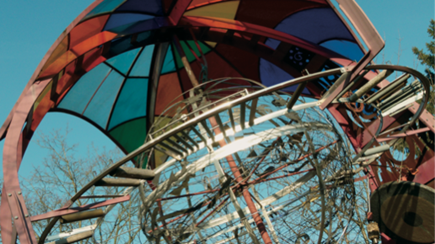
As a former Empa employee, Arthur Bechtiger designed his sound sculpture to mark the 700th anniversary of the founding of the Swiss Confederation (Federal Charter of 1291). Bechtiger later took the pseudonym Giustino Corradini and worked as a freelance artist. Bechtiger wrote about the Globophonium: "The Globophonium is associated with a remnant of hope and with the invitation to participate in the history of our generations with all our senses".
Arthur Bechtiger alias Giustino Corradini
Globophonium
1992
Sound sculpture made of metal and glass
Empa-Eawag campus, between the metal hall and the X-ray center, Dübendorf






